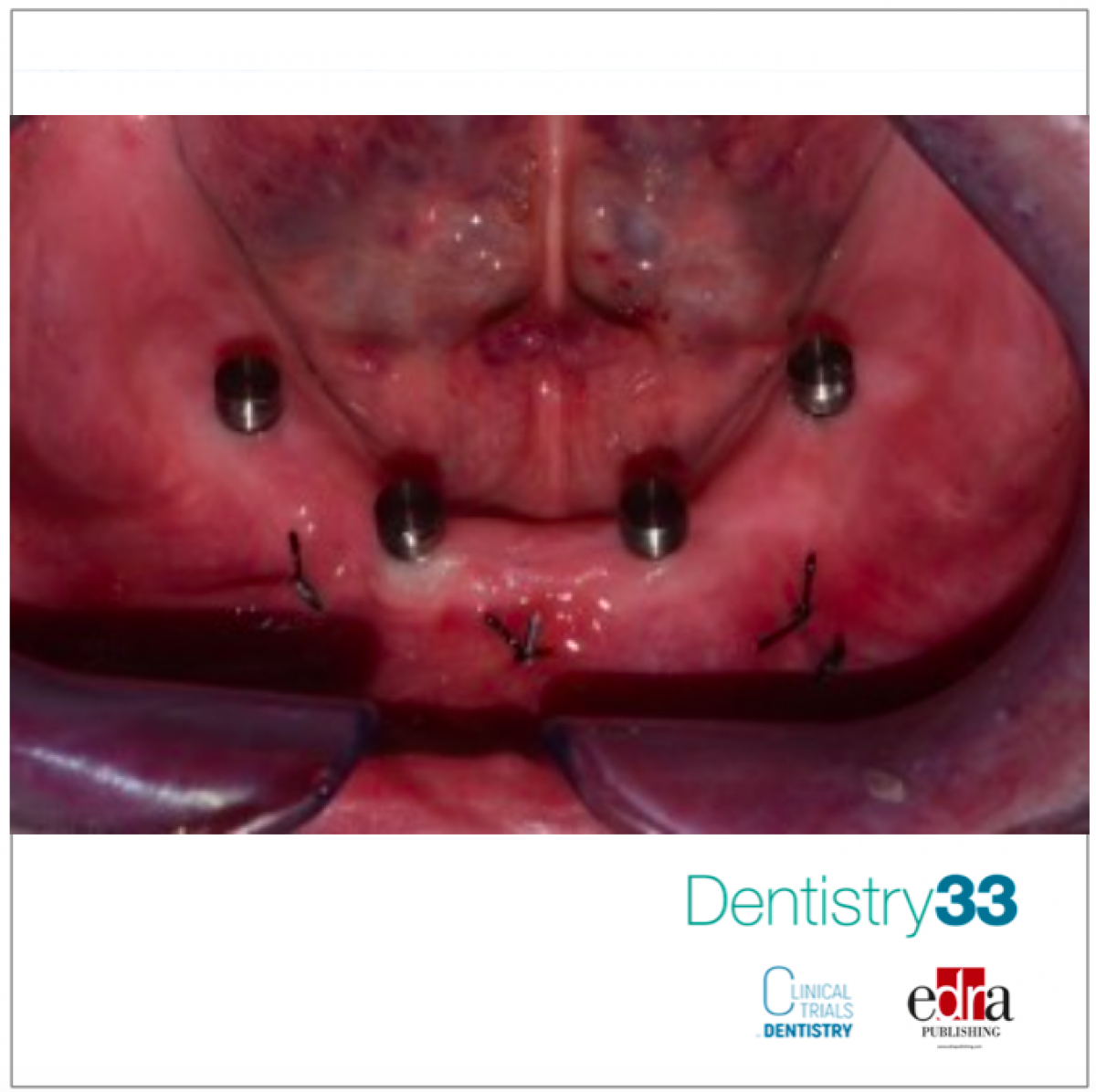
Two Mini implants: is immediate loading a predictable alternative ?
Lara Figini
Edentulism is mainly rehabilitated with complete dentures worldwide. Patients who remain dissatisfied with their mandibular complete denture may convert it into an implant-supported overdenture with the installation of two conventional diameter implants. When available ridge bone width is lacking, two, three, or four narrow diameter or mini implants may be employed. The connection of overdentures to the implants may be performed on the day of surgery providing an immediate loading procedure.
The aims of this cohort study were to compare bone loss around conventional and mini implants and identify any risk factors involved.
Materials and methods
Between 2015 and 2017 patients were screened and included if they were edentulous for at least 1 year and rehabilitated with a maxillary or mandibular complete dentures.
A mandibular cone-beam computed tomography was taken using each patient's complete denture as a reference with the addiction of radiopaque markers. Virtual implant planning was then carried out to select implant diameters and optimal positions. Based on the available buccal-lingual alveolar ridge bone width, two groups of patients were identified.
Group 1 had at least 5 mm in buccal-lingual width and received two conventional 4.1 mm diameter implants (Biomet 3i, Palm Beach Gardens, FL).
Groups 2 patients presented with at least 3.0-5 mm buccal-lingual width and received mini implants of 2.9 mm and 2.4 mm diameter. All the implants were installed between the mental foramina with a minimum distance between the implants of 10 mm .
During implant placement, peak insertion torque was recorded and if this reached at least 35 N cm an immediate loading protocol was applied. Locator (Zest Anchors Inc., Carlsbad, CA) abutments with the height varying from 2 to 6 mm were torqued to the implants. The height was selected according to the existing soft tissue height around each implant. Patients were instructed not to remove the lower overdenture until the time of suture removal (7 days later)
Results
Since no patients dropped the study, a total of 50 patients were analyzed. 25 receiving two conventional implants each (12 females, mean age of 65.3 ± 7.3 years, totaling 50 implants of 4.1 mm in diameter) and 25 receiving two mini implants each (11 females, mean age of 66.8 ± 8.1 years, totaling 42 implants of 2.9 mm and eight implants of 2.4 mm in diameter).
All implants achieved a minimum 35 N cm peak insertion torque enabling immediate loading .
Four early implant failures occurred; (n = 1) in the conventional diameter group and (n = 3) in the mini implants group (all of them with 2.9 mm in diameter), which was not statistically significant between groups (P > .05). Mini implants of 2.9 and 2.4 mm diameter presented significantly more bone loss after 12 months than conventional implants, more than 2 mm and less than 0.5 mm respectively, despite showing similar survival rates.
Conclusions
Within the limitations of this short-term report, the present bone loss findings during the first year of observations would suggest that two immediatly loaded mini implants should not be routinely considered for overdentures as the first choice of treatment.
The authors suggest that a longer follow up would be advisable to see if the resorption trend improves or worsens. However the use of four immediatly loaded narrow diameter implants to support overdentures, as previously described in the literature, could be a predictable alternative.
For additional Information: Immediately loaded mini‐implants supporting mandibular overdentures: A one‐year comparative prospective cohort study.
 Related articles
Related articles
A meta-analysis compared normal implants with implants of reduced height and diameter in supporting dental reconstructions of the overdenture type, even if it would be more correct to call them an...
The European dental overdentures and implant bridges market is poised for steady growth, according to a new report titled “Dental Overdentures Market Size, Share & Trends Analysis | Europe |...
Editorials 21 January 2025
A state-wide project led by oral surgeons from the University of Michigan School of Dentistry is focused on improving the oral health and well-being of older adults who have ill-fitting dentures.
Europe 04 May 2023 - 06 May 2023
Canary Islands, Spain – May 4 to 6, 2023
Edentulism2023, a conference with world-class speakers and experts, will provide an overview of treatment options and their associated level of scientific...
Prosthodontics 15 December 2022
Can the overdenture on roots still be a plausible alternative to the overdenture on implants?
The authors compared the results of prosthetic treatment for patients who wear complete maxillary dentures compared with a root-supported mandibular overdenture...
 Read more
Read more
Editorials 10 October 2025
With proud smiles and crisp white coats, ninety-three learners from the DDS Class of 2029 and the International Dentist Pathway Class of 2028 marked the start of their dental careers at the UCSF...
Periodontology 10 October 2025
Continuous professional development (CPD) in Periodontology refers to the overall framework of opportunities that facilitate a life-long learning practice, driven by the learner-practitioner and...
TheraBreath, the #1 alcohol-free mouthwash brand in the U.S.*, has introduced a new line of dentist-formulated, clinically tested toothpastes designed to support professional oral care...
News 10 October 2025
New officers and trustees were installed at the Minnesota Dental Association’s Leadership Conference on September 19 in Minneapolis.
News 10 October 2025
Smartee Denti-Technology today announced that Professor Gang Shen, its Chief Scientist and Executive President of TaiKang ByBo Dental, has once again been named to the World’s Top 2% Scientists...















